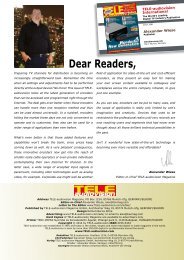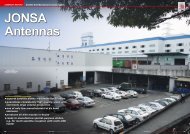eng TELE-audiovision 1305
The World’s Largest Digital TV Trade Magazine
The World’s Largest Digital TV Trade Magazine
Create successful ePaper yourself
Turn your PDF publications into a flip-book with our unique Google optimized e-Paper software.
is served; a single tuner<br />
couldn’t even process channels<br />
from different transponders<br />
at the same time<br />
anyway.<br />
The solution is multiple<br />
tuner server boxes so that,<br />
for example, the four levels<br />
of a satellite position can<br />
be received independently<br />
from each other and so that<br />
the parallel streaming of<br />
different transponders becomes<br />
possible. But even<br />
here there’s a little calculation<br />
that shows that this<br />
126 <strong>TELE</strong>-<strong>audiovision</strong> International — The World‘s Largest Digital TV Trade Magazine — 05-06/2013 — www.<strong>TELE</strong>-<strong>audiovision</strong>.com<br />
10<br />
12<br />
might not always be practical.<br />
A single HD channel<br />
typically needs a bandwidth<br />
of around 12MBPS. If you<br />
want to stream four of these<br />
channels to four different<br />
TVs, then it quickly adds up<br />
to 48MBPS and this would<br />
be too much for older WLAN<br />
routers or Access Points<br />
that can only handle up to<br />
56MBPS.<br />
You also have to take into<br />
account that a transport<br />
stream with a single HD<br />
channel and an audio track<br />
needs about 12MBPS, but<br />
when it’s converted into an<br />
IPTV packet, this rate actually<br />
bloats somewhat and<br />
then there’s all the entire<br />
headers that are required<br />
for all the data packets that<br />
10-12. vLc Installation<br />
11<br />
need to be considered as<br />
well. Another alternative is<br />
available if you can deal with<br />
reduced picture and audio<br />
quality. Instead of inserting<br />
the original transponder<br />
stream into the network,<br />
the received channels can<br />
be recompressed whereby<br />
a stronger compression is<br />
used.<br />
In this way the bandwidth<br />
of a channel can be reduced<br />
to a more reasonable 1MBPS<br />
but unfortunately, you’ll see<br />
this in the picture: all of a<br />
sudden the resolution will<br />
be greatly reduced and because<br />
of this compression<br />
typical artifacts will become<br />
visible such as blocks in the<br />
video and sloppy colors. A<br />
newly compressed stream<br />
like this though can be<br />
streamed in Unicast via the<br />
Internet. The advantage of<br />
IPTV is its incredible flexibility:<br />
a large assortment of<br />
devices can be used for reception<br />
such as computers,<br />
laptops, game consoles,<br />
tablets, Smartphones and,<br />
of course, IPTV compatibles<br />
TVs. And let’s not forget<br />
how WLAN solves the problem<br />
regarding the otherwise<br />
needed cabling.


















